Archive for March, 2012
An Hour of Frost
Well, it doesn’t take much. The forecast called for temperatures in my part of Fairfax County to dip below freezing for less than two hours, but that was enough to do some damage. At least one of the vines appears to have sailed through the night with flying colors, but the others experienced at least some degree of frost damage. As noted in my
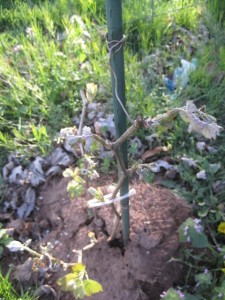
- Some damage on this vine – it’s hard to see in this picture, but compare the shriveled leaves on the right with the green, healthy ones on the left side.
previous post, this is a critical time of the year for vines. Late frost is a threat in any year, but the early bud break this spring left vines everywhere in the state exposed to the threat of frost in the weeks ahead.
As WineMaker magazine noted, late frost is a danger “because the first green growth produced on a new grapevine shoot is two or three basal leaves, immediately followed by the embryonic flower clusters that will become this year’s crop. So, if frost strikes, it can greatly reduce or even wipe out the whole vintage.”
For my vines in Fairfax, I believe the danger is even more acute because they are still small and the buds are so close to the ground, where the temperature is coldest. We’re still new at this, and it’s possible we pruned them back too far over the winter. For the vines we plant this spring, we’ll definitely be focused on strategies for dealing with late frost, and I’ll talk about some of them in an upcoming post.
Of course, one of the most important considerations in dealing with frost is site selection, and we’ve already cast that particular die. The Fairfax vineyard is challenged on at least two counts. It’s at a low elevation, and it’s on flat ground, so the cold air has no place to go. In Nelson County, where we have some vines planted and are preparing to plant another 150, the elevation is higher, around 750 feet, but not high enough to put us in the atmospheric sweet spot that probably runs from about 800 to 1,600 feet above sea level. On the other hand, the land is sloped, so the heavier cold air should flow down hill and off the vineyard. We’ll see.
But no matter how well you plan, you may still find yourself dealing with late frost. I suspect most commercial vineyards in the state were monitoring the vines throughout the night and taking steps to mitigate the frost threat. Larger vineyards have a number of tools they can bring to bear, including wind machines, heaters, and helicopters. Many vineyards gather the wood pruned from the vines over the winter and leave it at the end of the rows to burn on nights where frost threatens.
This year, we didn’t have a lot of choices beyond praying and hoping. However, the Fairfax vineyard is only experimental; I’m not expecting to ever make wine from those grapes, although it would be a definite bonus if I do. But for the vines we are putting in the ground this Spring, we’ll probably have some sleepless spring nights in our future.
The Perils of an Early Spring
We arrived home Sunday afternoon to find that the vines in our Fairfax vineyard were blooming in a magnificent way. I had pruned them during the winter, when they were still dormant, and have been wondering ever since if I had cut cut them back too severely. When I saw them on Sunday, though, I felt vindicated. Yes! Yes ! They would be up to the first wire (30 ” – or maybe 36″, I actually haven’t put the trellis in yet) in no time flat, I assumed.
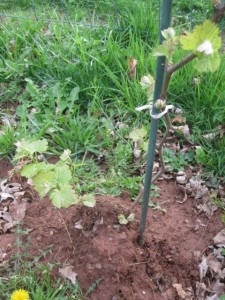
The Fairfax vineyard is a bit overrun with weeds right now, but you can see the leaves on this vine if you look closely.
I couldn’t have been happier. Until I showed the vines to my wife, the Vineyard Goddess.
“Well, that’s good and bad,” she said. Good, of course, because the vines looked so healthy and productive. But mostly bad, because, it’s still March and we could have some frost ahead of us. The bud break I observed on my vines had come very early in the season. And when she glanced over my shoulder at this post, she added another rule of thumb for vineyard management: “March will always be too early for bud break.”
And of course she was right. (She’s pretty much always right. Thank God she’s watching over our vineyard.) This evening, I found an email alert from Tony Wolf, the Virginia Tech viticulture specialist, and probably the state’s foremost expert on all things viticultural, warning of the likelihood of freezing temperature overnight. According to NOAA ‘s web site, temperatures will drop to about 31 degrees tonight in Afton, the site of our Nelson County vineyard, and 30 degrees in Fairfax, where the aforementioned vines are Continue Reading–>
Building the Trellis, Part I
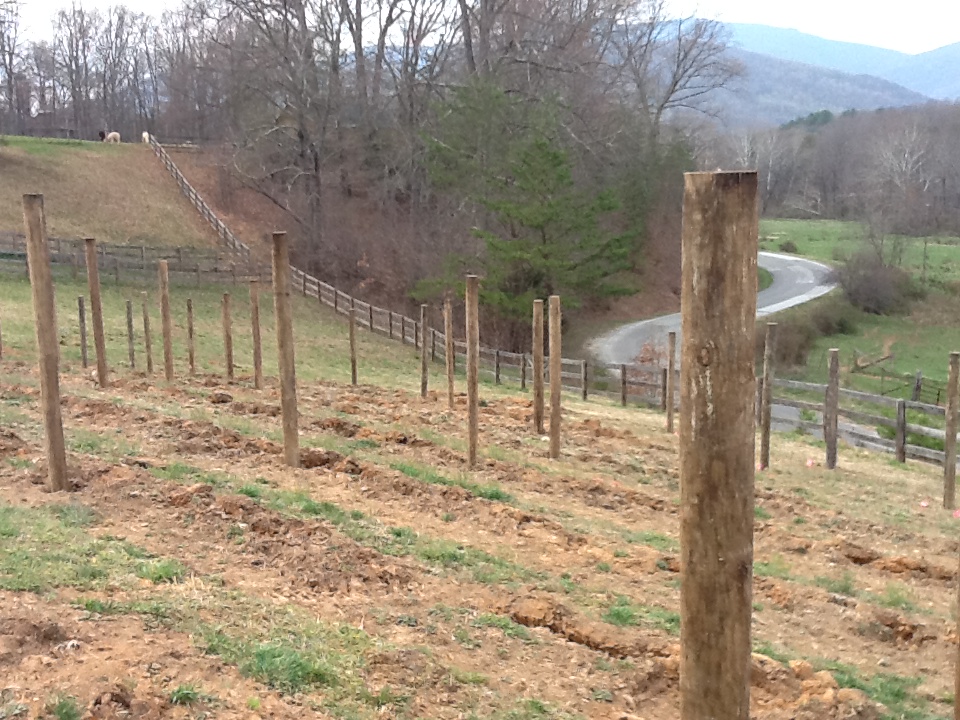
Here's how the vineyard looked last weekend, March 17. The posts are in the ground, the rows have been ripped, and it's beginning to look like a real vineyard! You can see our neighbors, the Alpacas, on the hill, top left.
How we built the trellis
Well, I have to be honest, I didn’t exactly build it myself. Much as I wanted to install the posts with my own hands, I ended up short on time with the planting season upon us. We needed to get the vines in the ground, pronto.
I’d spent much of the winter, between viticulture classes, my job and all of the work that goes into maintaining two separate properties, thinking about how to handle the trellis. There were moments when it seemed simple enough — eight foot posts put 24 to 30 inches into the ground, plus some kind of end-post system, which would be only slightly more complicated. And then, there were times when I wondered if I was up to the job.
As part of the planning, I did some research on what kind of equipment I’d need to buy or rent. A lot of the literature suggests that the best way to put posts into the ground is to pound them in, but the equipment involved would have made that impractical for me to do on my own. The easiest way to get the posts in is to drill the holes with an auger.
So, I briefly considered the idea of a hand-held power auger, which was the least expensive approach, or an auger for my tractor. I spent a lot of time visualizing the process, and considering whether it would be more cost-effective to do it myself or hire someone to do the work. I was pretty confident I could get the line posts in without a problem, but I spent a lot more time worrying about the end posts, which are more complicated. At some point, I began waking up at 4 a.m. to worry about how much work needed to be done and wonder if the vines we had ordered were destined to just, uh, rot on the vine? No, bad metaphor. Go to seed? mmmm…. no, that doesn’t work either. Wither and die? Well, something like that.
Eventually, we passed the point where I could reasonably expect that it would be Continue Reading–>

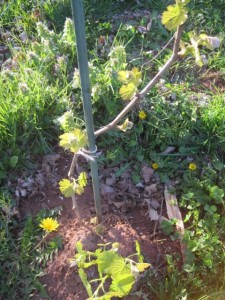
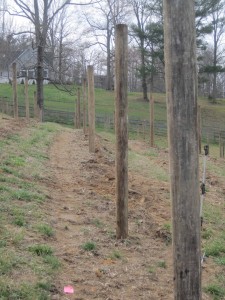


Recent Comments